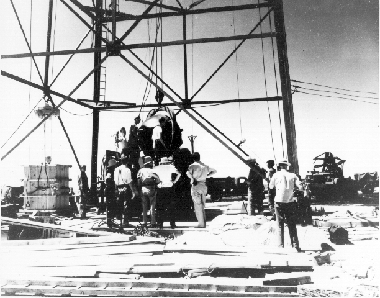Travel Pages
RomWell Travel Advisory
The Code Name Trinity
The origin of the code name Trinity for the test site is also interesting, but the true source is unknown. One popular account attributes the name to J. Robert Oppenheimer, the scientific head of the Manhattan Project. According to this version, the well read Oppenheimer based the name Trinity on the fourteenth Holy Sonnet by John Donne, a 16th century English poet and sermon writer. The sonnet started, "Batter my heart, three-personed God."
Another version of the name's origin comes from University of New Mexico historian Ferenc M. Szasz. In his 1984 book, The Day the Sun Rose Twice, Szasz quotes Robert W. Henderson head of the Engineering Group in the Explosives Division of the Manhattan Project. Henderson told Szasz that the name Trinity came from Major W. A. (Lex) Stevens.
According to Henderson, he and Stevens were at the test site discussing the best way to haul Jumbo the thirty miles from the closest railway siding to the test site.
"A devout Roman Catholic, Stevens observed that the railroad siding was called 'Pope's Siding.' He [then] remarked that the Pope had special access to the Trinity, and that the scientists would need all the help they could get to move the 214 ton Jumbo to its proper spot."
RELATED LINKS:
 Learn About Trinity - The First Atomic Test
Learn About Trinity - The First Atomic Test

Education
Discover where the capital of the United States has been located...Recommended Literature
100 Suns - By Michael Light - Between July 1945 and November 1962 the United States is known to have conducted 216 atmospheric and underwater nuclear tests. After the Limited Test Ban Treaty between the United States and the Soviet Union in 1963, nuclear testing went underground. It became literally invisible—but more frequent: the United States conducted a further 723 underground tests, the last in 1992. 100 Suns documents the era of visible nuclear testing, the atmospheric era, with 100 photographs drawn by Michael Light from the archives at Los Alamos National Laboratory and the U.S. National Archives in Maryland. It includes previously classified material from the clandestine Lookout Mountain Air Force Station based in Hollywood, whose film directors, cameramen and still photographers were sworn to secrecy.
The title, 100 Suns, refers to the response by J. Robert Oppenheimer to the world’s first nuclear explosion in New Mexico when he quoted a passage from the Bhagavad Gita, the classic Vedic text: “If the radiance of a thousand suns were to burst forth at once in the sky, that would be like the splendor of the Mighty One... I am become Death, the destroyer of worlds.” This was Oppenheimer’s attempt to describe the otherwise indescribable. 100 Suns likewise confronts the indescribable by presenting without embellishment the stark evidence of the tests at the moment of detonation. Since the tests were conducted either in Nevada or the Pacific the book is simply divided between the desert and the ocean. Each photograph is presented with the name of the test, its explosive yield in kilotons or megatons, the date and the location. The enormity of the events recorded is contrasted with the understated neutrality of bare data.
Interspersed within the sequence of explosions are pictures of the awestruck witnesses. The evidence of these photographs is terrifying in its implication while at same time profoundly disconcerting as a spectacle. The visual grandeur of such imagery is balanced by the chilling facts provided at the end of the book in the detailed captions, a chronology of the development of nuclear weaponry and an extensive bibliography. A dramatic sequel to Michael Light’s Full Moon, 100 Suns forms an unprecedented historical document.
The Day the Sun Rose Twice: The Story of the Trinity Site Nuclear Explosion, July 16, 1945 by Ferenc Morton Szasz - First published in 1984, this prize-winning history of the Manhattan Project was available in paperback for the first time, fifty years after the explosion of the first atomic bomb. "This tightly focused, lucidly written and thoroughly researched book... describes the events, personalities and scientific processes that led to the detonation of the first atomic bomb in an isolated stretch of New Mexican desert.... Mr. Szasz provides fascinating details.... The Day the Sun Rose Twice is concise and cogent, a valuable introduction to how our nuclear dilemma began." — New York Times Book Review
"May be the definitive account of the days and hours leading up to the first nuclear explosion in history and the legacy it left. He vividly reconstructs the story: the industrious atmosphere of the scientists and technicians; the grave considerations of those making key decisions; the sense of wonder, and twinges of conscience, at what had been achieved." — Los Angeles Times
RECOMMENDED MOVIE:
The Day After Trinity - This unique movie is a haunting journey through the dawn of the nuclear age, an incisive history of humanity's most dubious achievement and the man behind it -- J. Robert Oppenheimer, the principal architect of the atomic bomb. Featuring archival footage and commentary from scientists and soldiers directly involved with the Manhattan Project, this gripping film is a fascinating look at the scope and power of the Nuclear Age.


